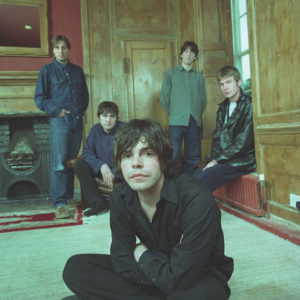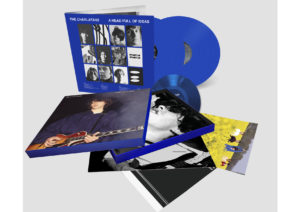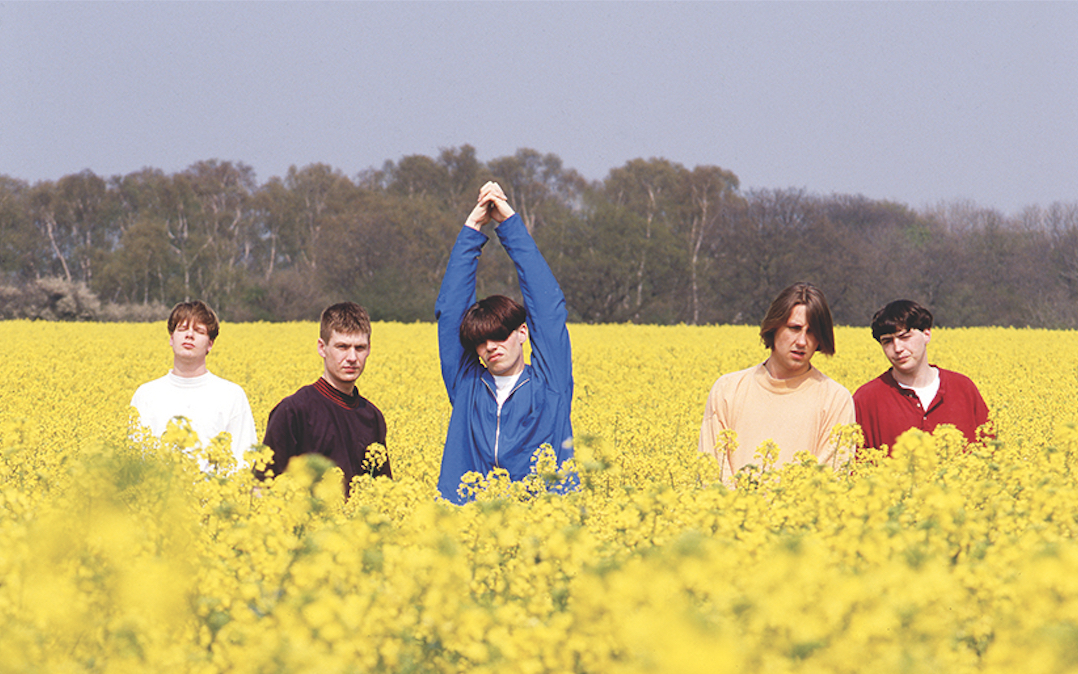The first response to any mention of The Charlatans in North America is usually: “Who?” After a memory jostle in the form of singing the refrain of their universally appealing single “The Only One I Know” the response changes to, “Oh yeah…are they still around?”
The British group, who broke through at the time of the Madchester craze in the very early ’90s, has the stigma of a one-hit wonder Stateside—at least for non-Anglophile music lovers. In their home country, however, The Charlatans are not only a revered and enduring group, with 13 studio albums in their rearview, but their frontperson Tim Burgess is a cultural icon. “At least we’ve got a way in,” chuckles Burgess via Zoom from London, referring to the enduring hit single. Burgess isn’t too concerned about breaking through to anyone who’s not already a fan. The Charlatans are celebrating their 30-year anniversary with a hefty box set, A Head Full of Ideas. Currently, they’re playing multiple dates in good-sized venues across England for three consecutive months. Whenever they come to North America, the group packs out 500-plus capacity rooms.
The Charlatans were not the favorites to outlive the Madchester movement—but they did, while their contemporaries imploded. They were absorbed into the Britpop era and rose to the top, somehow avoiding the fallout when 90 percent of the bands under that classification disappeared. “There were certain times where we didn’t feel like we fit in,” says Burgess. “But by The Charlatans [in 1995], all of a sudden we were in the middle of it, and Tellin’ Stories [1997], in a way, was a celebration of coming out on top.”
Despite Burgess’ well-documented substance abuse, which he speaks about candidly in his 2013 memoir Telling Stories, The Charlatans have stood fast. Their original guitarist, Jon Baker, left after their 1990 debut album, Some Friendly. “That was really Rob’s album,” says Burgess referring to the group’s late keyboard player, Rob Collins. “He double-tracked every part, which was amazing. It was a Hammond organ–driven album. The second album, Rob put a lot of pressure on Jon, and I don’t know that Jon wanted the pressure. It’s still debatable in my mind whether he left or was pushed out. I think it was a combination of both. He had amazing hair though.”
“When Jon Brookes died, we got back together and felt his presence in the room, continuously. It was almost like we continued to be together because of something so traumatic. We kept together in many ways because of who we lost.”
Mark Collins, Baker’s replacement, helped take The Charlatans to musical places that would not have been possible with Baker. Plus, he was a fair match to his same-last-name bandmate, who was the most enigmatic and issue-prone of the bunch. First Rob Collins had a stint in jail—which worked heavily against the band internationally, particularly in the U.S—and then he died in a car crash in 1996 during the making of The Charlatans’ pivotal album Tellin’ Stories. “There were lots of times when I thought, ‘Is it going to work without him?’” says Burgess. “It was pretty hard. Even though we had Martin Duffy [of Primal Scream] helping us finish Tellin’ Stories, it was really difficult to think that we could continue without Rob. Jon Brookes [The Charlatans’ late drummer] definitely wanted to continue. He was a powerful person and led from the back a lot.”
Sixteen years and six albums after Tellin’ Stories, Brookes died of a brain tumor in 2013 while The Charlatans were recording Modern Nature. “We tried really hard to make a record with Jon when he was ill, but he couldn’t physically do it, and it was awful to see. When he died, we got back together and felt his presence in the room, continuously. It was almost like we continued to be together because of something so traumatic. We kept together in many ways because of who we lost.”

photo by Tom Sheehan
A Head Full of Ideas—which comes as a six-piece, blue vinyl box set including a special 7-inch retrospective—is a true testament to The Charlatans’ staying power, their songwriting, and their musicianship, not to mention Burgess’ sharp lyricism. The release is also available on a triple LP (or CD), including a collection of greatest hits under the title A Head Full of Ideas, a 13-track record of live versions called Trust Is for Believers, an 11-track collection of demos called Pleased to Meet You, and an eight-track collection of remixes called One to Another. These are the favorites from The Charlatans’ lengthy catalog with the demos and live versions being exceptional offerings.
“I had to ask fans for the demos that everybody seems to have apart from me,” says Burgess. “When we first started, we sent demos out to record companies, but we made too many and the people in the record shop in Northwich [Burgess’ hometown] had them. There were spares that got onto fan sites and got duplicated. Some people had the actual cassettes and we mastered from those.” Among these found demos is “C’mon, C’mon,” a brand-new (old) song that Burgess doesn’t remember singing. “I was doing a lot of drugs and drinking too much, so on some level I would have forgotten about it,” he says. “It sounds like a single. I don’t have any idea why we didn’t put it on Wonderland.” The live recordings similarly trace back to very early days and are culled from festivals and stellar gigs, including a performance of their very first single “Indian Rope” from the Reading Festival in 1992. “Rob made it his own and I stood back and watched,” recalls Burgess.
“The Listening Parties have taken over my life. And that’s OK… I thought it might last three weeks. I don’t think anybody could have predicted how long it was going to last—the Listening Party or the pandemic.”
Coinciding with the release of A Head Full of Ideas is Burgess’ fourth book, The Listening Party. Since the start of the pandemic, Burgess’ “Tim’s Twitter Listening Party” has become a global gathering place. Every day, including weekends, Burgess plays host to longtime musician friends (of which he has many) and brand new artists who discuss a particular album from their discography via tweets, as they and fans listen to the album in real time. At well over a million replays, these have become much larger virtual events than the listening parties Burgess has held on Twitter for the last 10 years, focused on The Charlatans’ albums and his own solo material. “The Listening Parties have taken over my life,” says Burgess. “And that’s OK. I planned the first three weeks, doing one a day at 10 in the evening U.K. time because I wanted to give an alternative to BBC News at Ten. It very quickly became three a day. I thought it might last three weeks. I don’t think anybody could have predicted how long it was going to last—the Listening Party or the pandemic.”
Over 100 of the Listening Parties have been collected in The Listening Party book—Burgess’ second book to be released in 2021 (his first, One Two Another: Line by Line: Lyrics from the Charlatans, Solo and Beyond, came out in January). The idea of a book of tweets sounds underwhelming, but the book contains over 150 pages of not just tweets but rare photographs, setlists, handwritten notes, stickers, illustrations, and, of course, album covers. Burgess has written a short introduction for each Listening Party, which range from Oasis to Culture Club, The Chemical Brothers to The Smiths, Fontaines D.C. to New Order. The publisher, DK Books, will be making a donation to Music Venue Trust for its #SaveOurVenues campaign, and Burgess is donating all his royalties to the cause as well.

“I was convinced of what the book should be like, but when I actually held it in my hands I thought, ‘It’s really thick. It feels important.’ I was so pleased,” says Burgess who is marking the 1,000th Listening Party with Blondie’s Parallel Lines on October 28. The Listening Parties slot between The Charlatans’ tour dates (or is it the other way around?), with the band’s current lineup including Pete Salisbury, formerly of The Verve, who is sitting in for Brookes. There are only two of the original members—Burgess and bassist Martin Blunt—but it seems to be working for them.
“As a teenager, I always liked bands who had the same members from the word ‘go,’” says Burgess. “With Jon Baker leaving, my vision of The Charlatans changed immediately. Martin and I are the two surviving members, and we are completely the opposites of each other, and it’s totally fine. We get on better now than we ever have. He doesn’t really like everything I do and that’s fine. Sometimes what he likes, I’m not into. But together we can come up with something that seems to work. Me and Mark like the same stuff, and Martin and Tony like the same stuff. When we bring things together, by tuning into what everyone’s trying to get across, it often works. Contrasting personalities make good music.” FL







